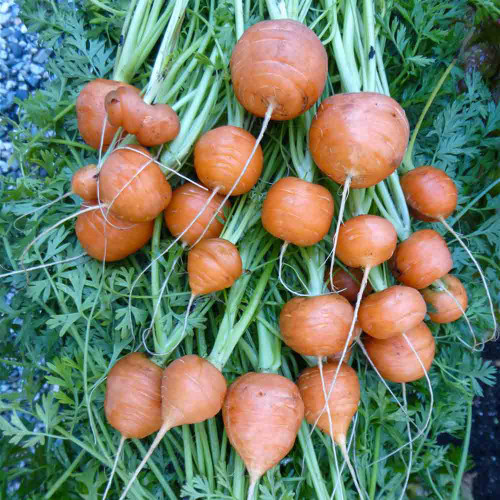Purple Dragon Carrot Seeds - (Daucus carota var. sativus)
- SKU:
- V1028
- Seed Count:
- 500 seeds per pack
- Days to Maturity:
- 60-90 days
- Shape:
- Tapered
- Days to Germination:
- 6-21 days @ 50-75F
- Plant Spacing:
- 1-2"
- Light Preference:
- Full sun
- Soil Requirements:
- Light, sandy or humus, well drained soil
- Status:
- Heirloom, Non-Hybrid, Non-GMO seeds
Description
Purple Dragon Carrot - The Most Refined Purple Carrot Available
Purple Dragon stands out among a wave of newly introduced purple carrots - for several reasons. It’s gorgeous, fascinatingly deep reddish-purple skin is just the right color, drawing your eye. The strikingly intense orange interior hints at the flavors without giving everything away, because this isn’t just another uniquely colored, moderately sweet carrot. The rich spicy-sweet, addictively complex flavors are good when fresh but amazing when cooked, releasing more of the spice notes – not in a pepper spiciness way, but an old-world bazaar spice way.
As if all of this wasn’t enough, they grow well and taste delicious in almost any soil – from sand to clay. They taste better after the first frosts but beat almost all other carrots by a country mile in the middle of summer. They can reach 7 – 8”, but their half-long root habit means they grow well-formed roots even in heavy soil.
Many who usually don’t like carrots love the Dragon for their lovely spiciness that balances the natural carrot sweetness.
History
Carrots originated in Europe and Central Asia. The first cultivated variety had branching purple roots and is believed to have been developed in Afghanistan. It migrated to the Mediterranean in the 14th century and then northwards. The orange varieties were developed in the Netherlands in the 17th century.
Uses
Coarsely or finely grated carrots are eaten raw as a salad. They are one of the most widely used vegetables they are cut, sliced, diced, cooked, steamed or juiced. Carrots are included in soups and stews and used in sauces and stocks.
Harvest Tip
Give carrots a good twist when you pull them up so that the leaves do not break off in your hand, but once they are up, cut off the leaves right away. Carrot tops may look pretty, but they keep growing and draw moisture and nourishment out of the roots, leaving them limp, wrinkled and tasteless.
Learn More
- Grow Delicious Carrots from Seed to Harvest
- Braised and Marinated Carrot Recipes
- Cool Season Vegetables to Love
From the soil to the seed to the food you eat - we'll help you grow your best garden!













